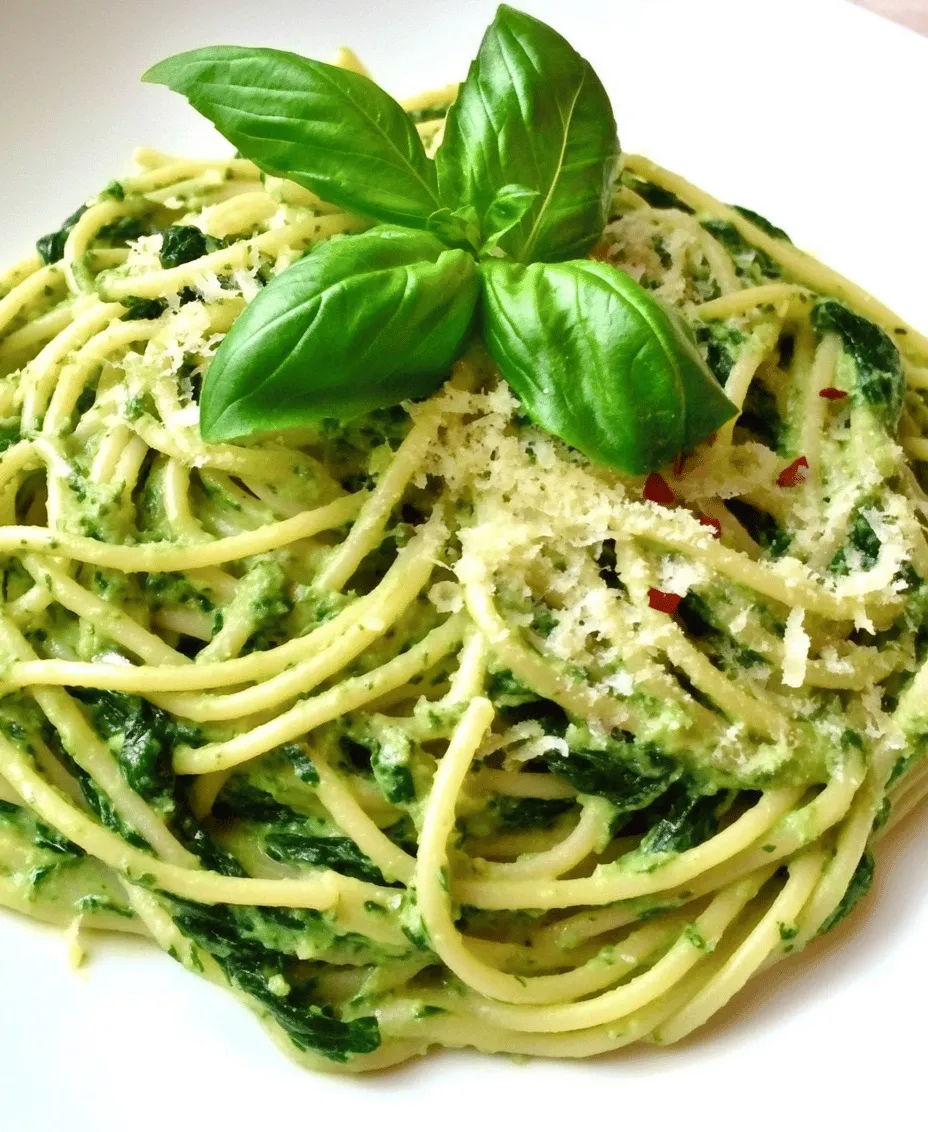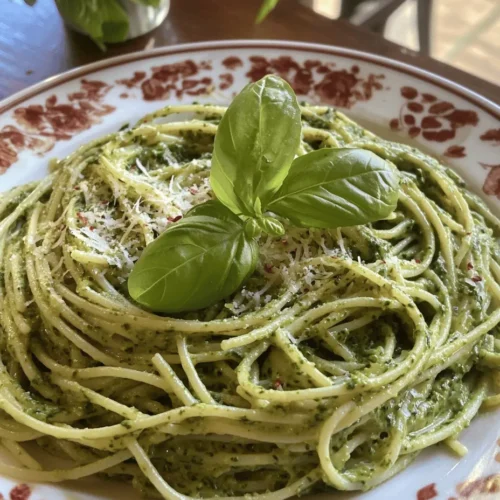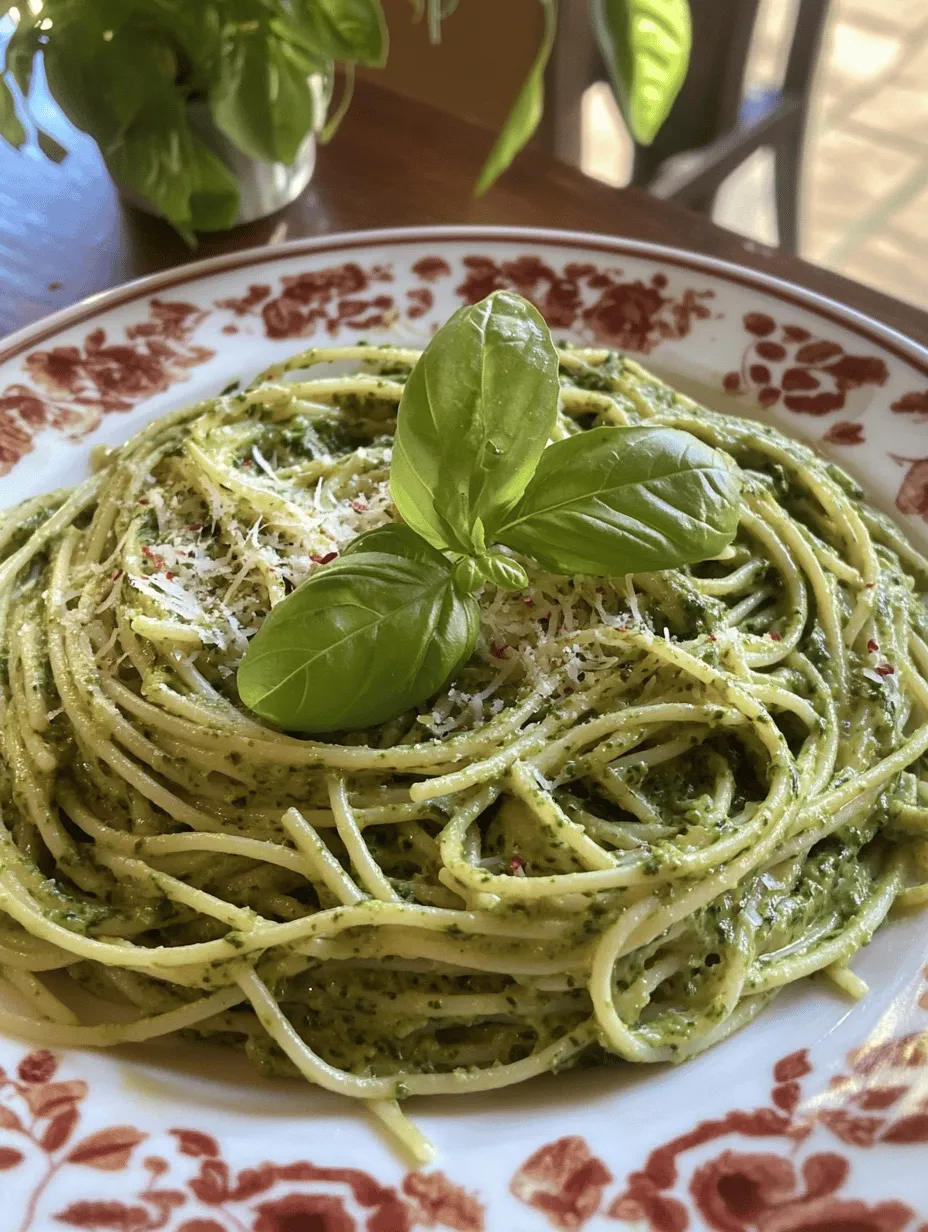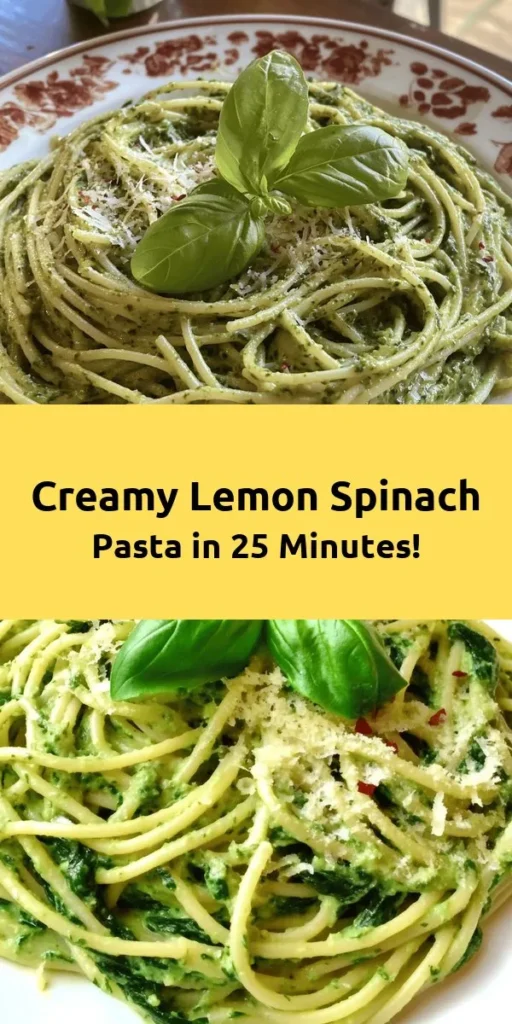Introduction
Lemon Spinach Pasta is a delightful dish that perfectly balances vibrant flavors and rich textures. This recipe melds the freshness of spinach with the zesty brightness of lemon and the comforting creaminess of pasta, creating a meal that is both satisfying and invigorating. Whether you’re preparing a weeknight dinner for the family, hosting a dinner party, or just craving something light yet indulgent, this dish has got you covered. Its versatility allows it to shine in various settings, from casual dinners to elegant gatherings.
One of the key aspects of this Lemon Spinach Pasta is the importance of using fresh ingredients. Fresh spinach, zesty lemons, and high-quality pasta all contribute to an elevated flavor profile that pre-packaged or frozen alternatives simply cannot replicate. The combination of these fresh elements not only enhances the visual appeal of the dish but also boosts its nutritional value, making it a wholesome option for any meal.
Understanding the Ingredients
To create a truly memorable Lemon Spinach Pasta, it’s essential to understand the role and benefits of each key ingredient.
Fresh Spinach
Spinach is the star of this dish, providing a nutritional powerhouse of vitamins A, C, and K, along with essential minerals like iron and calcium. Its mild flavor complements the pasta without overpowering it, while also adding a vibrant green color that makes the dish visually appealing. Spinach is also known for its versatility; it can be used in salads, smoothies, or as a main ingredient in various cooked dishes. When cooked, spinach wilts down significantly, allowing you to incorporate a generous amount into your pasta without overwhelming the dish.
Lemon
Lemon plays a pivotal role in Lemon Spinach Pasta, introducing a bright acidity that balances the richness of the cream and the pasta. The zest and juice of the lemon not only enhance the flavor but also elevate the overall profile of the dish, making it feel lighter and fresher. The acidity from the lemon can cut through the creaminess, ensuring that the dish does not feel heavy. Additionally, lemons are packed with vitamin C, which further boosts the nutritional value of the meal.
Heavy Cream
Heavy cream adds a luxurious richness to the pasta, creating a silky sauce that coats each strand of pasta beautifully. This creamy element balances the acidity of the lemon and the earthiness of the spinach, resulting in a harmonious blend of flavors. While heavy cream is typically high in calories, it can be used judiciously to achieve the desired creaminess without overwhelming the dish. For those looking for lighter alternatives, options such as half-and-half or a cream substitute can be explored.
Garlic
Garlic is the aromatic foundation of this dish, enhancing the overall taste and providing depth. Its savory notes complement the other ingredients, while also adding a delightful fragrance to the cooking process. When sautéed, garlic develops a sweet, mellow flavor that enhances the dish without being overpowering. However, it’s important to pay attention while cooking garlic; it can burn quickly and turn bitter if left unattended.
Parmesan Cheese
Parmesan cheese is the finishing touch that ties the dish together, adding a depth of flavor and a savory umami element. Grated or shaved, this cheese melts beautifully into the creamy sauce, contributing to its richness. Additionally, Parmesan is a great source of protein and calcium, making it a beneficial addition to your meal. For those looking for a dairy-free alternative, nutritional yeast can replicate a similar cheesy flavor.
Optional Ingredients
While the above ingredients are essential for the base of this dish, there are several optional ingredients that can elevate your Lemon Spinach Pasta even further.
– Red Pepper Flakes: If you enjoy a bit of heat, red pepper flakes can add a spicy kick to the dish. Just a pinch can enhance the overall flavor profile without overpowering the other ingredients, making it a great addition for those who enjoy a little zest.
– Fresh Basil: Adding fresh basil not only enhances the dish’s aroma but also introduces a layer of complexity with its sweet and peppery notes. The vibrant green of the basil also adds aesthetic appeal, making the dish even more inviting. Fresh herbs can elevate any pasta dish, and basil pairs particularly well with the flavors of lemon and garlic.
Step-by-Step Preparation of Lemon Spinach Pasta
Now that we understand the importance of each ingredient, let’s dive into the step-by-step preparation of this delightful Lemon Spinach Pasta.
Cooking the Pasta
1. Bring Water to a Boil: Start by bringing a large pot of water to a rolling boil. The amount of water should be sufficient to allow the pasta to move freely as it cooks.
2. Salt the Water: Once the water is boiling, add a generous amount of salt. Salting the water is crucial as it is the only opportunity to season the pasta itself. Aim for a salt concentration reminiscent of ocean water, which will enhance the pasta’s flavor.
3. Add the Pasta: Add your choice of pasta to the boiling water. For this dish, linguine, fettuccine, or spaghetti work exceptionally well. Stir occasionally to prevent sticking.
4. Cook to Al Dente: Follow the package instructions for cooking time but aim for al dente texture, where the pasta is cooked but still has a slight firmness when bitten. This typically takes about 8-12 minutes, depending on the pasta type. Remember to reserve a cup of pasta water before draining; this starchy water can be invaluable for adjusting the sauce’s consistency later.
Sautéing Spinach and Garlic
1. Heat the Pan: In a large skillet, heat a couple of tablespoons of olive oil over medium heat. This oil will serve as the base for sautéing the spinach and garlic.
2. Add Garlic: Once the oil is shimmering, add minced garlic to the skillet. Sauté for about 30 seconds until fragrant, being cautious not to let it brown. Burnt garlic can impart a bitter taste to the dish.
3. Add Spinach: Gradually add the fresh spinach to the skillet. It may seem like a lot at first, but spinach wilts down significantly. Stir frequently as the spinach wilts, ensuring even cooking. This process should take about 2-3 minutes.
4. Season: As the spinach wilts, season it lightly with salt and pepper. This step is essential as it allows the flavors to develop and meld together.
Creating the Creamy Lemon Sauce
1. Incorporate Heavy Cream: Once the spinach is wilted and the garlic is fragrant, reduce the heat to low and pour in the heavy cream. Stir to combine, allowing the cream to warm through without boiling.
2. Add Lemon Juice and Zest: Squeeze the juice of one lemon into the skillet and add the zest as well. The acidity from the lemon will brighten the sauce, cutting through the richness of the cream. Stir to combine.
3. Adjust Consistency: If the sauce seems too thick, add a splash of the reserved pasta water, stirring until you reach your desired consistency. This starchy water not only helps thin the sauce but also helps it adhere to the pasta.
4. Finish with Parmesan: Finally, stir in the grated Parmesan cheese, mixing until it melts into the sauce, adding a layer of savory flavor. Taste and adjust seasoning with more salt, pepper, or lemon juice if needed.
In this part of the recipe article, we’ve laid the groundwork for creating a delicious Lemon Spinach Pasta, focusing on the ingredients and initial preparations. The combination of fresh spinach, zesty lemon, and creamy elements creates a dish that is not only flavorful but also visually appealing and nutritious. In the next part, we will explore serving suggestions and tips for perfecting this delightful pasta dish.

Techniques for Achieving the Right Sauce Consistency
To create the perfect sauce for your Lemon Spinach Pasta, mastering the right consistency is key. A sauce that is too thick can overwhelm the delicate flavors of lemon and spinach, while one that is too thin may not adhere well to the pasta. Here’s how to achieve that ideal creamy texture:
1. Reduce the Sauce: Start by cooking your sauce over medium heat, allowing it to simmer gently. This will help concentrate the flavors and thicken the sauce. Stir occasionally to prevent sticking or burning.
2. Incorporate a Thickening Agent: If your sauce is still too watery after reducing, consider adding a small amount of all-purpose flour or cornstarch mixed with cold water to thicken it further. This should be done gradually to avoid clumps.
3. Emulsification: A technique to elevate the sauce’s texture is emulsifying it with the pasta water. The starch released from the pasta helps bind the sauce and pasta together, creating a silky coating.
Combining Ingredients
When combining your pasta with the sauce, timing is everything. The ideal approach is as follows:
1. Cook the Pasta Al Dente: Begin by boiling your pasta in generously salted water until it’s al dente. This typically means cooking it for 1-2 minutes less than the package instructions suggest.
2. Reserve Pasta Water: Before draining your pasta, make sure to reserve about a cup of the starchy cooking water. This water can be a lifesaver for adjusting your sauce’s consistency.
3. Combine Off the Heat: Once the pasta is cooked and drained, immediately add it to the sauce in the pan. Mixing off the heat prevents overcooking the pasta and allows you to maintain that perfect texture.
Importance of Timing When Combining Pasta and Sauce
Timing between cooking the pasta and preparing the sauce is crucial. The goal is to have both elements ready at the same time for the best results:
– Simultaneous Cooking: Start cooking the pasta as soon as your sauce is simmering. This ensures that when your pasta is ready, your sauce is hot and waiting.
– Immediate Mixing: Combine the pasta and sauce right after draining the pasta. The heat from the pasta will help to warm the sauce, creating a seamless blend of flavors.
Adjusting Sauce Consistency with Reserved Pasta Water
The reserved pasta water is essential for achieving the right sauce consistency. Here’s how to use it effectively:
– Gradual Addition: As you mix the pasta with the sauce, start by adding a splash of reserved pasta water. This will help loosen the sauce without making it watery.
– Mix and Assess: Toss the pasta and sauce together while adding the water incrementally. Keep an eye on the consistency, aiming for a creamy, cohesive sauce that clings to the pasta.
Final Touches
The finishing touches can elevate your Lemon Spinach Pasta to a whole new level:
1. Incorporating Cheese for Creaminess: For that extra creamy texture, add freshly grated Parmesan or Pecorino Romano cheese directly into the sauce. Stir until melted and combined. If you prefer a vegan option, consider nutritional yeast as a substitute.
2. Seasoning to Taste: Always taste your sauce before serving. The balance of flavors is crucial. Adjust with additional salt, freshly cracked black pepper, or a hint of red pepper flakes for heat. A squeeze of fresh lemon juice can also brighten the flavors further.
Serving Suggestions
Plating your Lemon Spinach Pasta beautifully enhances the dining experience:
1. Ideal Ways to Plate the Dish: Use a large, shallow bowl or a plate to showcase the pasta. Twirl the pasta into a nest in the center of the plate, allowing the sauce and spinach to cascade over the top.
2. Pairing Options with Sides or Beverages: This pasta pairs wonderfully with a crisp green salad tossed in a light vinaigrette. For beverages, consider a chilled white wine such as Pinot Grigio or Sauvignon Blanc, which complements the citrus notes perfectly.
3. Tips for Garnishing for Presentation: Fresh herbs like basil or parsley can add a pop of color and freshness. A sprinkle of additional cheese on top and a twist of lemon zest will not only enhance the flavor but also make for an appealing presentation.
Nutritional Information
Understanding the nutritional content of your Lemon Spinach Pasta can help you appreciate its health benefits:
– Breakdown of Calories and Nutritional Content per Serving: A typical serving of Lemon Spinach Pasta contains approximately 350-400 calories, depending on the amount of cheese and oil used. It provides a good balance of carbohydrates, proteins, and fats.
– Health Benefits of Key Ingredients: Spinach is rich in vitamins A, C, and K, and is a great source of iron and antioxidants. Lemons provide vitamin C and aid in digestion, while whole grain pasta offers fiber that supports gut health.
– Considerations for Dietary Preferences: This dish is naturally vegetarian and can easily be adapted for vegan diets by omitting cheese or using dairy-free alternatives.
Variations of Lemon Spinach Pasta
This recipe is versatile, allowing for various adaptations to suit different dietary needs:
1. Suggested Ingredient Swaps for Different Diets: For those on a low-carb or gluten-free diet, consider using spiralized vegetables (like zucchini) instead of pasta or gluten-free pasta alternatives made from chickpeas or lentils.
2. Dairy-Free Options for Cream and Cheese: If you’re avoiding dairy, you can create a creamy sauce using coconut milk or cashew cream. Nutritional yeast can replace cheese for a similar umami flavor.
3. Additional Protein Options: For a heartier meal, add grilled chicken, sautéed shrimp, or cubed tofu to the pasta. These proteins can enhance the dish’s nutritional profile and make it more filling.
4. Seasonal Variations Using Other Greens or Citrus Fruits: Feel free to experiment with seasonal greens like kale or arugula, and switch lemon for lime or even orange for a different citrus twist.
Conclusion
Lemon Spinach Pasta is a delightful dish that marries simplicity with vibrant flavors. Its bright lemon notes and nutritious spinach make it a wholesome meal that’s quick to prepare and satisfying. Whether you stick to the classic recipe or venture into the world of variations, this dish offers endless possibilities for creativity in the kitchen.
Cooking is a joyful experience, and sharing meals with family and friends brings a special kind of happiness. So gather your loved ones, whip up this Lemon Spinach Pasta, and enjoy the flavors of home-cooked goodness together. Happy cooking!



